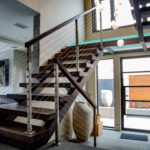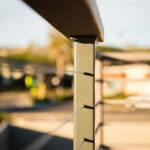Interpretation of Glass Railing Codes
Glass railings allow us to preserve our views while also providing a safe and attractive wind break on exterior decks. Interior uses for glass panels are also numerous when we consider modern stairways, lofts and breezeways often encountered in high end homes. According to some sources glass creation has been around for 4000 years or more and used in architecture for hundreds of years. We know it works well, but todays codes can be hard to understand when it comes to glass panel railings. Included below are some of the more commonly encountered topics about glass railing codes pertaining to railing projects:
One of the most popular questions we receive about glass railing codes is “Do I need a top rail on my glass railing?”
The answer is Yes and possibly No…
According to the ICC (International Code Council) – Guards with structural glass baluster panels shall be installed with an attached top rail or handrail. The top rail or handrail shall be supported by a minimum of three glass baluster panels. Or shall be otherwise supported to remain in place should one glass baluster panel fail.
Exception: An attached top rail or handrail is not required where the glass baluster panels are laminated glass with two or more glass plies of equal thickness and of the same glass type.
To break this down further : Two sheets of 1/4″ glass that are laminated together are considered to be one @ 1/2″ laminated glass panel. In theory the laminated panel would further prevent breaking and also prevent falling glass from leaving the railing infill. If you use this type of glass you MAY be exempt from using a top rail. ALWAYS check with your local building department.
Free Standing Glass Panels and Glass Clip Railing Systems
The previously referenced top rail and laminated glass railing codes most commonly pertain to free standing or clipped glass panels. These type of railing systems do not secure the glass with a top rail, thus requiring more stringent requirements that are harder to interpret. The safest way to guarantee that the requirements are met is by discussing the requirements with the local building authority. When it comes to building inspections the field inspector will ultimately have the final say and has likely encountered many glass railing projects.
Height and loading requirements for glass railings are very similar to cable railings and other balustrade railing types. In California, a 42″ net height is required for glass barrier railings. Stairs will require handrails between 34″ and 38″ high regardless of design. The lateral loading requirement of a minimum 200 lbs applied to the top rail at any location also applies to glass railings.
Minimum Panel Thickness for Glass Railings
The minimum panel thickness associated with most railing systems is 1/4″ thick tempered glass. Does railing glass have to be tempered?- Yes. Almost all architectural applications call for tempered glass. As far as the minimum thickness call out of 1/4″ glass; thicker glass is becoming more and more common these days. Frameless systems may require thicker glass and/or lamination as stated earlier in this post. 1/4″ glass is commonly seen in full framed glass railings like the photo above. Most tempered glass panels have a stamp, and this visible symbol is often required in order to pass inspection.
“Glazing” is the process of using glass (or other panelized materials) as an infill for windows, doors, railing panels etc. For the most part our modern railing codes deal with human impact, structural and/or wind loads associated with glass panels. Much of the published material on code requirements deals with glass thickness and also requirements involved with tempered glass.
San Diego Cable Railings furnishes complete glass railing systems. We offer wooden, steel and aluminum framing options for interior and exterior glass applications. Additionally, we are an authorized distributor of Feeney design rail systems. For customers who require a turnkey sales and installation; we have a network of preferred installers specializing in glass railing installation. If you have questions about glass railing codes or would like an estimate for a glass railing system; please visit the quote request page.



